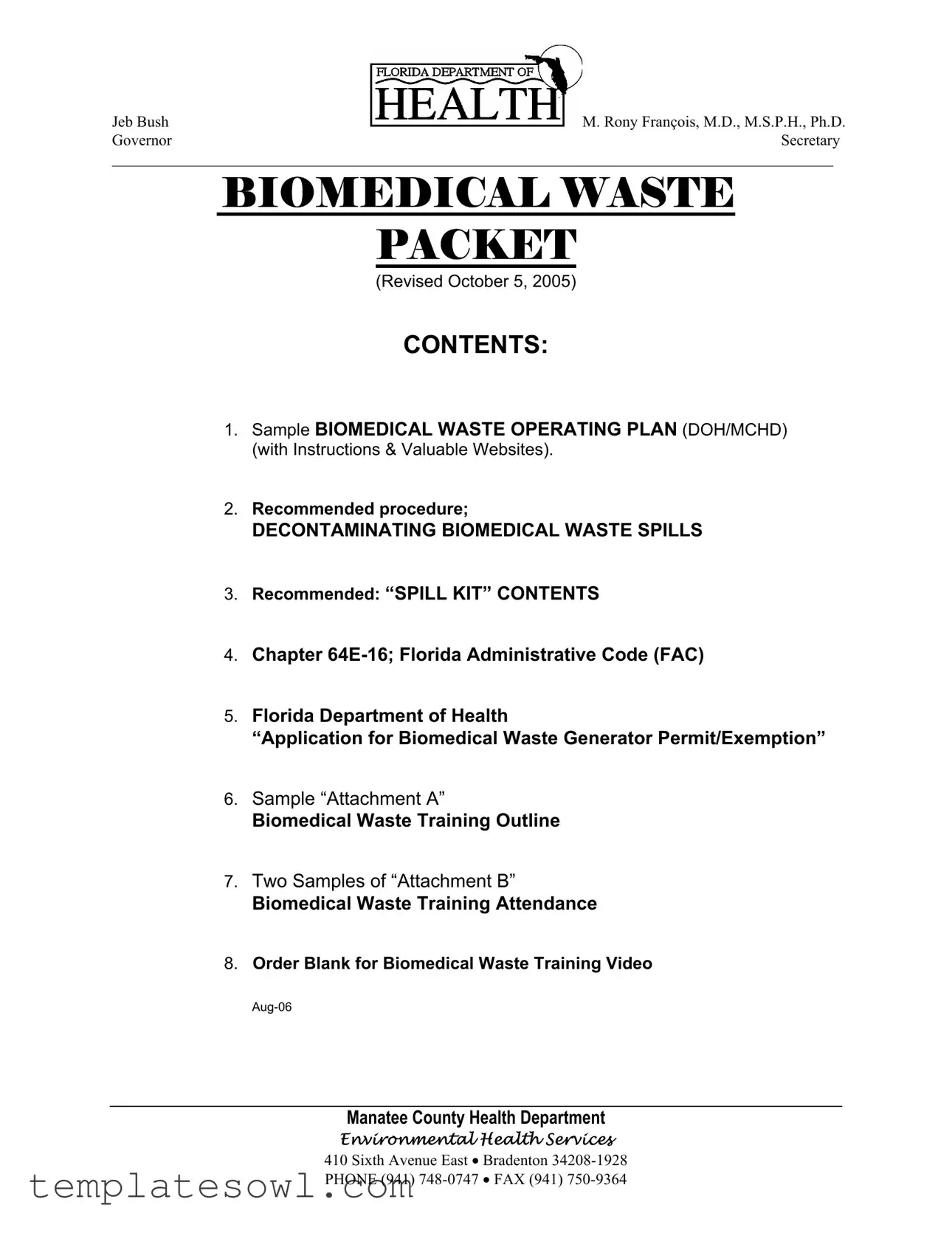Jeb Bush |
|
M. Rony François, M.D., M.S.P.H., Ph.D. |
|
Governor |
|
Secretary |
____________________________________________________________________________________________
BIOMEDICAL WASTE
PACKET
(Revised October 5, 2005)
CONTENTS:
1.Sample BIOMEDICAL WASTE OPERATING PLAN (DOH/MCHD) (with Instructions & Valuable Websites).
2.Recommended procedure;
DECONTAMINATING BIOMEDICAL WASTE SPILLS
3.Recommended: “SPILL KIT” CONTENTS
4.Chapter 64E-16; Florida Administrative Code (FAC)
5.Florida Department of Health
“Application for Biomedical Waste Generator Permit/Exemption”
6.Sample “Attachment A”
Biomedical Waste Training Outline
7.Two Samples of “Attachment B”
Biomedical Waste Training Attendance
8.Order Blank for Biomedical Waste Training Video
Aug-06
Manatee County Health Department
ENVIRONMENTAL HEALTH SERVICES
410Sixth Avenue East • Bradenton 34208-1928 PHONE (941) 748-0747 • FAX (941) 750-9364
BIOMEDICAL WASTE OPERATING PLAN
FACILITY NAME (1)
TABLE OF CONTENTS
I.DIRECTIONS FOR COMPLETING THE BIOMEDICAL WASTE PLAN
II.PURPOSE
III.TRAINING FOR PERSONNEL
IV. DEFINITION, IDENTIFICATION, AND SEGREGATION OF BIOMEDICAL WASTE
V.CONTAINMENT
VI. LABELING VII. STORAGE VIII. TRANSPORT
IX. PROCEDURE FOR DECONTAMINATING BIOMEDICAL WASTE SPILLS
X.CONTINGENCY PLAN XI. BRANCH OFFICES XII. MISCELLANEOUS
ATTACHMENT A: BIOMEDICAL WASTE TRAINING OUTLINE
ATTACHMENT B: BIOMEDICAL WASTE TRAINING ATTENDANCE
ATTACHMENT C: PLAN FOR TREATMENT OF BIOMEDICAL WASTE (Not Included; Available upon request)
Use of this plan format is voluntary and not required by the Department of Health. It is provided as a service to assist biomedical waste facilities in complying with the requirements of Chapter 64E-16, F.A.C.
I. DIRECTIONS FOR COMPLETING THE BIOMEDICAL WASTE PLAN
Blank 1: Enter the name of your facility.
Blank 2: Enter where you keep your employee training records.
Blank 3: List the items of biomedical waste that are produced in your facility and the location where each waste item is generated.
Blank 4: Enter the name of the manufacturer of your facility’s red bags. This company must be
on the Department of Health (DOH) list of compliant red bags (this list can be obtained from the following website: www.doh.state.fl.us/environment/community/biomedical/red_bags.htm) or from your DOH biomedical waste coordinator OR you must have results supplied by the bag manufacturer from an independent laboratory that indicate that your red bags meet the
bag construction requirements of Chapter 64E-16, Florida Administrative Code (F.A.C.). If your facility does not use red bags, enter N/A.
Blank 5: Indicate where the documentation for the construction standards of your facility’s red bags is kept. or if your facility does not use red bags, enter N/A.
Blank 6: Indicate where unused, red biomedical waste bags are kept in operational areas (not in stock or in central storage) so that working staff can get them quickly when they need them. If your facility does not use red bags, enter N/A.
Blank 7: Enter the place where your biomedical waste is stored. 1.How is this area “Washable”?
2.Is this area “Out of the Client Traffic Area” (how)? 3. How is this area’s access restricted? If your biomedical waste is picked up by a licensed biomedical waste transporter
but you have no storage area, indicate your procedure for preparing your biomedical waste for pick-up. If you have no pick-up and no storage area, enter N/A.
Blank 8: Enter all the required information about your registered biomedical waste transporter. The website www.doh.state.fl.us/environment/community/biomedical/transporters.htm has a list of such transporters. If you do not use a transporter, enter N/A.
Blank 9: Enter the name(s) of the employee(s) designated to transport your facility’s untreated biomedical waste to another facility. If your facility does not transport your own biomedical waste, enter N/A.
Blank 10: Enter the name of the facility to which your facility transports your own untreated biomedical waste. If your facility does not transport your own biomedical waste, enter N/A.
Blank 11: Describe the procedure and products your facility will use to decontaminate a spill or leak of biomedical waste.
Blank 12: Enter the required information about the registered biomedical waste transporter who will transport your biomedical waste on a contingency basis.
Blank 13: If personnel from your facility also work at a branch office of your facility, enter the name of the branch office. If you have no branch office, enter N/A.
Blank 14: Enter the street address, city, and state of the branch office named in (13). If you have no branch office, enter N/A.
Blank 15: Enter the weekdays the branch office named in (13) is open. If you have no branch office, enter N/A.
Blank 16: Enter the normal work hours for each day the branch office named in (13) is open. If you have no branch office, enter N/A.
Blank 17: Indicate where a copy of this biomedical waste operating plan will be kept in your facility.
Blank 18: Indicate where the current biomedical waste permit or exemption document will be kept in your facility.
Blank 19: Indicate where your facility will keep its current copy of the biomedical waste rules, Chapter 64E-16, F.A.C.
Blank 20: Indicate where your facility will keep copies of its biomedical waste inspections from at least the last three (3) years.
Blank 21: If your facility transports your own biomedical waste, indicate where your transport log is kept. If you do not transport your own biomedical waste, enter N/A.
Attachment A: Activities addressed should be those from Section III that are carried out in your facility.
Attachment B: Enter the required information to document training sessions.
Attachment C: To be completed only if your facility treats biomedical waste. If your facility has untreated biomedical waste removed by a registered transporter or you transport your own untreated waste, do not complete this attachment.
II.PURPOSE
The purpose of this Biomedical Waste Operating Plan is to provide guidance and describe requirements for the proper management of biomedical waste in our facility. Guidelines for management of biomedical waste are found in Chapter 64E-16, Florida Administrative Code (F.A.C.), and in section 381.0098, Florida Statutes.
III. TRAINING FOR PERSONNEL
Biomedical waste training will be scheduled as required by paragraph 64E- 16.003(2)(a), F.A.C. Training sessions will detail compliance with this operating plan and with Chapter 64E-16, F.A.C. Training sessions will include all of the following activities that are carried out in our facility:
Definition and Identification of Biomedical Waste Segregation
Storage
Labeling
Transport
Procedure for Decontaminating Biomedical Waste Spills Contingency Plan for Emergency Transport Procedure for Containment
Treatment Method
Training for the activities that are carried out in our facility is outlined in Attachment A.
Our facility must maintain records of employee training. These records will be kept
(2)
Training records will be kept for participants in all training sessions for a minimum of three (3) years and will be available for review by Department of Health (DOH) inspectors. An example of an attendance record is appended in Attachment B.
IV. DEFINITION, IDENTIFICATION, AND SEGREGATION OF BIOMEDICAL WASTE Biomedical waste is any solid or liquid waste which may present a threat of infection
to humans. Biomedical waste is further defined in subsection 64E-16.002(2), F.A.C.
Items of sharps and non-sharps biomedical waste generated in this facility and the
locations at which they are generated are:
(3)
If biomedical waste is in a liquid or semi-solid form and aerosol formation is minimal, the waste may be disposed into a sanitary sewer system or into another system approved to receive such waste by the Department of Environmental Protection or the DOH.
V.CONTAINMENT
Red bags for containment of biomedical waste will comply with the required physical properties.
Our red bags are manufactured by
(4)
Our documentation of red bag construction standards is kept
(5)
Working staff can quickly get red bags at
(6)
Sharps will be placed into sharps containers at the point of origin.
Filled red bags and filled sharps containers will be sealed at the point of origin. Red bags, sharps containers, and outer containers of biomedical waste, when sealed, will not be reopened in this facility. Ruptured or leaking packages of biomedical waste will be placed into a larger container without disturbing the original seal.
VI. LABELING
All sealed biomedical waste red bags and sharps containers will be labeled with this facility’s name and address prior to offsite transport. If a sealed red bag or sharps container is placed into a larger red bag prior to transport, placing the facility’s name and address only on the exterior bag is sufficient.
Outer containers must be labeled with our transporter’s name, address, registration number, and 24-hour phone number.
VII. STORAGE
When sealed, red bags, sharps containers, and outer containers will be stored in areas that are restricted through the use of locks, signs, or location. The 30-day storage time period will commence when the first non-sharps item of biomedical waste is placed into a red bag or sharps container, or when a sharps container that contains only sharps is sealed.
Indoor biomedical waste storage areas will be constructed of smooth, easily cleanable materials that are impervious to liquids. These areas will be regularly maintained in a sanitary condition. The storage area will be vermin/insect free. Outdoor storage areas also will be conspicuously marked with a six-inch international biological hazard symbol and will be secure from vandalism.
Biomedical waste will be stored and restricted in the following manner:
(7)
VIII. TRANSPORT
We will negotiate for the transport of biomedical waste only with a DOH-registered company. If we contract with such a company, we will have on file the pick-up receipts provided to us for the last three (3) years. Transport for our facility is provided by:
a.The following registered biomedical waste transporter: Company name (8)
Address
Phone
Registration number
Place pick-up receipts are kept
OR
b. An employee of this facility who works under the following guidelines:
We will transport our own biomedical waste. For tracking purposes, we will maintain a log of all biomedical waste transported by any employee for the last three (3) years. The log will contain waste amounts, dates, and documentation that the waste was accepted by a permitted facility. Name of employee(s) who is(are) assigned transport duty:
(9)
Biomedical waste will be transported to: (10)
IX. PROCEDURE FOR DECONTAMINATING BIOMEDICAL WASTE SPILLS (11)
X.CONTINGENCY PLAN
If our registered biomedical waste transporter is unable to transport this facility’s biomedical waste, or if we are unable temporarily to treat our own waste, then the following registered biomedical waste transporter will be contacted:
Company name (12)
Address
Phone
Registration number
XI. BRANCH OFFICES
The personnel at our facility work at the following branch offices during the days and times indicated:
1)Office name (13) Office address (14)
Days of operation (15) Hours of operation (16)
2)Office name (13) Office address (14)
Days of operation (15) Hours of operation (16)
XII. MISCELLANEOUS
For easy access by all of our staff, a copy of this biomedical waste operating plan will be kept in the following place:
(17)
The following items will be kept where indicated:
a.Current DOH biomedical waste permit/ exemption document (18)
b.Current copy of Chapter 64E-16, F.A.C. (19)
c.Copies of biomedical waste inspection reports from last three (3) years (20)
d.Transport log (21)
ATTACHMENT A: BIOMEDICAL WASTE TRAINING OUTLINE
Facility Name:
Trainer’s Name:
Outline:








